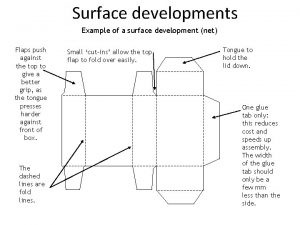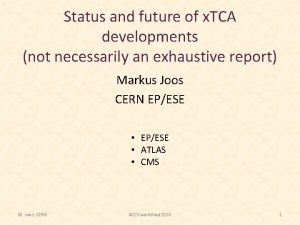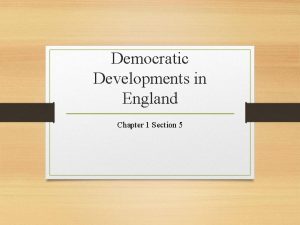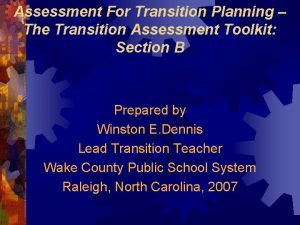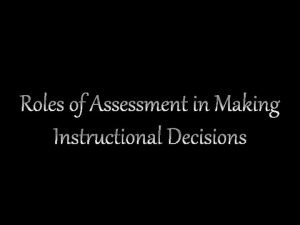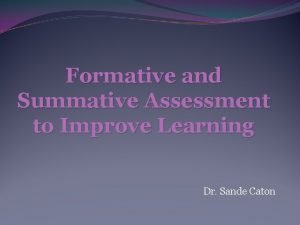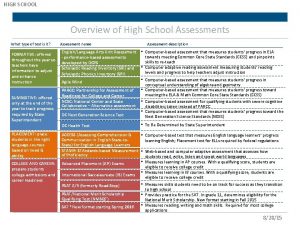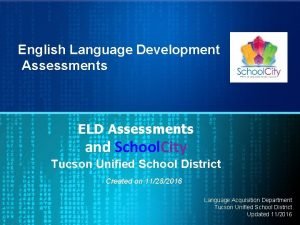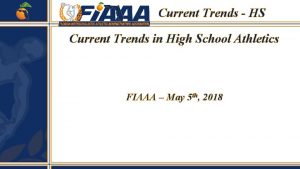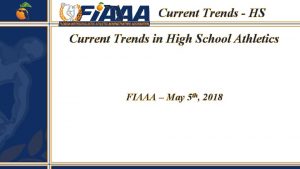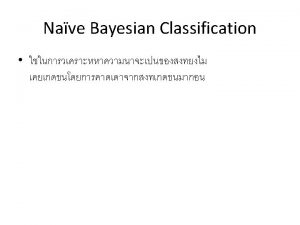High School Assessments Major Developments and Trends Sunny



































- Slides: 35

High School Assessments: Major Developments and Trends Sunny Deye, Education Program Principal Oklahoma House Interim Committee September 26, 2013

High School Assessments: A Shift to College and Career Readiness • Why College and Career Readiness? • State of the States - Exit and End-of-Course Exams • Students Affected • Main Types of Exams • Subjects Tested • Alternative Options for Students Who Don’t Pass • Are They Meeting Their Intended Purpose? • The Future / State Trends

Context: Emphasis on College and Career Readiness MAP TITLE

Why College and Career Readiness? Changing Economy

Why College and Career Readiness? The Rise of Middle-skill Jobs High-skill jobs Occupations in the professional/technical and managerial categories. Often require four-year degrees and above Middle-skill jobs Occupations that include clerical, sales, construction, installation/repair, production, and transportation/material moving. Low-skill jobs Occupations in the service and agricultural categories. Source: Achieve, Inc.

Why College and Career Readiness? 80% of Oklahoma’s jobs are middle or high skill Yet only 32% of Oklahoma’s adults have some postsecondary degree (associate’s or higher) Source: Achieve, Inc.

Why College and Career Readiness? Too Few Students Graduating Ready for Success Source: Achieve, Inc.

Why College and Career Readiness? Too Few Students Earning Postsecondary Degrees Percent of Students Earning a Postsecondary Degree Source: Achieve, Inc.

Why College and Career Readiness? Income and Job Security Source: Achieve, Inc.

Why College and Career Readiness? Of Every 100 9 th Graders in Oklahoma… Source: Achieve, Inc.

How are states defining College and Career Readiness? Some combination of: • Courses • Standards • Tests • Skills Oklahoma uses courses and standards to meet the college and work ready definition

College and Career Readiness: Courses Research shows that students who take the recommended core curriculum are more likely to be ready for college or career than those who do not. Core curriculum is defined as: • 4 years of English • 3 years each of: • Mathematics • Social studies • Science Oklahoma is one of 23 states with graduation requirements at this level

College and Career Readiness: Standards All 50 states have adopted College and Career Ready English language arts/literacy and mathematics standards: • 4 states have developed and adopted their own College and Career Readiness standards (Alaska, Nebraska, Texas and Virginia). • 46 states adopted the Common Core State Standards anchored in what it takes to be ready for college and careers. Oklahoma adopted the Common Core State Standards in 2010

College and Career Readiness: Tests In 2012, 18 States Administer Tests Aligned with CCR Expectations National College Admissions Test State-Developed Assessment Source: Achieve, Inc.

College and Career Readiness: Skills Source: David T. Conley, EPIC

So what does this all mean for high school assessments? Students are taking a wide variety of high school assessments for different purposes: • School accountability • Graduation • College admissions / placement

Elements of Comprehensive K-12 Assessment System • Testing should support and reflect good teaching • Tests should assess the full range of College and Career Ready standards to prepare students for postsecondary success • High school test results should open doors to higher education and good jobs for students • Reaching a certain score on the state assessment should mean that a student is on track for success in college and career Source: Achieve, Inc.

The National Perspective on High-stakes Testing: Exit and End-of. Course Exams Comprehensive exams are taken by all students at a particular grade level, usually grade 10 or 11. • 18 states are administering or plan to administer comprehensive exit exams End-of-course (EOC) exams are administered to students as they complete a specific course and assess mastery of the content for that course • 9 states require students to pass end-of-course exams to graduate

Which States Have Exit Exams?

How Many Students are Affected by Exit Exams? Source: Center on Education P

What Subjects are Tested on Exit Exams? All 26 states with current or planned exit exam policies test students in English language arts, and most also test in mathematics. I’ve provided you with a two-page handout that shows Types of High School Exit Exams and Subjects Tested in 2011 -12. You’ll see that there are quite a few states that require students to pass comprehensive tests, often only in reading/writing and math. States with End-of-Course exams more frequently test students in subjects in addition to English language arts and math.

How Does Oklahoma Compare? States with End-of-Course Exams tied to Graduation Requirements in 2012: State Subjects Tested Arkansas Must pass 2: Algebra I, English II (2015) Indiana Must pass 2: Algebra I, English 10 Louisiana Must pass 3: English II or English III, Algebra I or Geometry, and Biology or U. S. History Maryland Must pass 3: English 2, Algebra/Data Analysis, Biology Massachusetts Must pass 3: Comprehensive exam in ELA and math; EOC exam in Biology, Chemistry, Introductory Physics, or Technology/Engineering Mississippi Must pass 4: Algebra I, English II, U. S. History, Biology I New York Must pass 4: ELA, math, science, social studies courses Oklahoma Must pass 4: Algebra I and English II, and two of the following: Algebra II, Geometry, English III, Biology I, U. S. History Must pass 6: Reading, Writing, at least one mathematics (Algebra I, Geometry, Algebra II); at least one science (Earth Science, Biology, Chemistry); at least one history and social science (World History to 1500, World History from 1500 to the Present, World Geography, Virginia/U. S. History); and at least one additional test (may be mathematics, science, or history and social science) Virginia

How Many Students Pass Exit Exams? The percentage of students who pass exit exams on the first try: 70% to 90%

What Options are Available for Students Who Do Not Pass Exit Exams? • 26 states - Opportunities to retake before 12 th grade • 26 states - Opportunities to retake after 12 th grade Alternate paths to graduation include: • 12 states – Alternative assessments or substitute scores from ACT, SAT, other assessment • 8 states – Portfolio / End-of-course projects • 8 states – Waivers or appeals of exit exam requirements • 3 states – Opportunity to earn alternate diploma, such as a certificate of completion Four states offer no alternate paths to graduation.

What Options are Available for Oklahoma Students Who Do Not Pass Exit Exams? • Remediation and the opportunity to retake the test up to three times each calendar year • Students may earn a specified score on alternate tests such as the SAT, ACT, AP, IB, Work. Keys or a subject specific project • State Board of Education appeal process: A student who has been denied a standard diploma has 30 days to file a petition for an appeal to the Board, Board to take action within 45 days • Board to collect data by school site and school district on the number of students petitioning for an appeal and the number of appeals approved by the Board. Beginning October 1, 2012, the Board is to provide an annual report of this data to the Governor, President Pro Tempore of the State Senate and Speaker of the House of Representatives (2012 HB 2970)

When the Rubber Hits the Road: State Experiences with Implementation Florida: • Scheduled to take effect with class of 2003 • Large numbers of students projected to fail • Legislature approved “certificates of completion” to students who failed the FCAT • Instituted fast-track GED programs over the summer for those students • New legislation allowed scores on other exams—including the SAT, PSAT, ACT, PLAN, College Placement Test, and military entrance exams—to be substituted for FCAT results as a graduation requirement

When the Rubber Hits the Road: State Experiences with Implementation • Alternate diplomas or certificates – lack credibility • In 2009, 8 states with exit exam policies offered a certificate of attendance or certificate of completion to all students who did not meet the exit exam requirements • In 2012, only 3 states offered this option

State Trends – Future of Exit Exam Policies Some states adding: • Oklahoma (class of 2012) • Oregon (class of 2012) • Rhode Island (class of 2014) • Connecticut (class of 2020) Some states removing: • Alabama (class of 2015) • Georgia (class of 2015, though writing test remains) • North Carolina (eliminated 2011 -12 school year) • Tennessee (eliminated 2011 -12 school year)

State Trends – Future of Exit Exam Policies • Several states moving away from requiring exit exam to graduate • Instead are counting scores on end-of-course exams as a percentage of a student’s final grade in that course (Kentucky, North Carolina, and Tennessee)

State Trends – Future of Exit Exam Policies • Aligning exit exams to college-and career-readiness standards? • Most states with exit exams have also adopted the Common Core State Standards: • 10 states plan to replace their exams with the CCSS-aligned assessments being developed by PARCC • 3 states plan to use the common assessments being developed by the Smarter Balanced Assessment consortium • 2 states plan to replace their current exit exams with new state assessments aligned to the common standards but have not yet specified which exams

State Trends – Future of Exit Exam Policies College and Career Readiness • Research indicates that exit exams are seldom used for college admissions or other decisions by institutions of higher education and are not used much by employers despite the business community’s support for these policies. • Will realigning exit exams to college and career expectations mean exit exams hold more value for colleges and/or employers? Too soon to tell

Intended Purpose? American Educational Research Association (AERA) 2006 Research: • There are statistically significant associations between state exit exam policies and lower high school completion rates. • The rate at which 16 - to 19 -year-olds attempt a GED is statistically significantly higher in states with any type of exit exam. • The association between exit exams and lower high school completion increases as poverty rates increase and as the composition of states include greater shares of racial and ethnic minorities. • Evidence suggests that high stakes testing policies may inhibit "authentic" teaching and lead teachers to "teach to the test, " however more research is needed in this area.

More Kids Earning GED? University of Chicago (James Heckman), found in 2010 that: • GED recipients are not equivalent to high school graduates. They score closer to high school graduates on aptitude tests, but they experience labor market outcomes closer to dropouts. • Deficits in noncognitive factors (e. g. , lack of persistence, low selfesteem, low self-efficacy, propensity for risky behavior) explain the lack of success for many GEDs. • GED certification has little or no effect on labor market outcomes for the average test taker. • Many GED recipients enroll in college by age 22 but very few ever earn degrees or complete a meaningful amount of postsecondary education.

Impacts Unknown Impacts of exit exams on student achievement, dropout rates, and other outcomes for historically lower-performing groups are not fully known and have yet to be fully addressed. Disparities in passing rates for different student groups continue to be a concern in states with exit exams. Unresolved questions: • Have exit exams actually raised student achievement as intended? • Will these exams ever be meaningful indicators for institutions of higher education or employers? More monitoring, research, and evaluation needed

Sunny Deye sunny. deye@ncsl. org National Conference of State Legislatures 7700 E. First Place Denver, CO 80230 (303) 364. 7700 www. ncsl. org
 Sunny school
Sunny school Major trends in youth sports
Major trends in youth sports Recent developments in ict
Recent developments in ict Recent developments in object detection
Recent developments in object detection Cultural developments of sahelanthropus tchadensis
Cultural developments of sahelanthropus tchadensis Peter rosenwald
Peter rosenwald Political developments in the early republic
Political developments in the early republic Peter catana
Peter catana Chapter 11 political developments in the early republic
Chapter 11 political developments in the early republic What is surface development
What is surface development Gte milano
Gte milano In the colonial era developments such as the new england
In the colonial era developments such as the new england Target developments
Target developments Description
Description Pattern development
Pattern development Comtel atca
Comtel atca Democratic developments in england
Democratic developments in england Cplim
Cplim Surface developments
Surface developments Medical development international
Medical development international American grassfed association standards
American grassfed association standards How did parliament emerged victorious in medieval england
How did parliament emerged victorious in medieval england The catcher in the rye chapter 13
The catcher in the rye chapter 13 General revision of assessments and property classification
General revision of assessments and property classification Informal assessments for transition planning
Informal assessments for transition planning 9it’s sunny and hot in
9it’s sunny and hot in Assessing strengths and weaknesses
Assessing strengths and weaknesses What is a context clue
What is a context clue Assessment formative summative diagnostic
Assessment formative summative diagnostic Physical fitness grade 9
Physical fitness grade 9 Weather sunny rainy cloudy windy stormy
Weather sunny rainy cloudy windy stormy Summative
Summative Crescenta valley high school summer school
Crescenta valley high school summer school Haltom high school summer school
Haltom high school summer school Why is earth called the blue planet
Why is earth called the blue planet Catcher in the rye sunny
Catcher in the rye sunny









